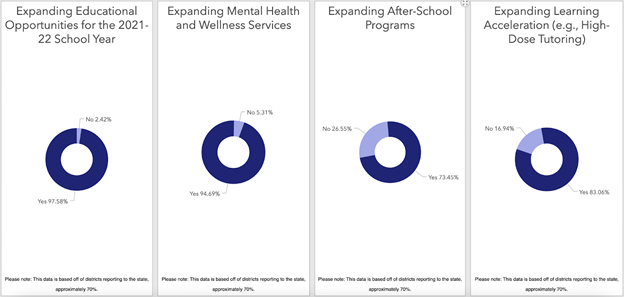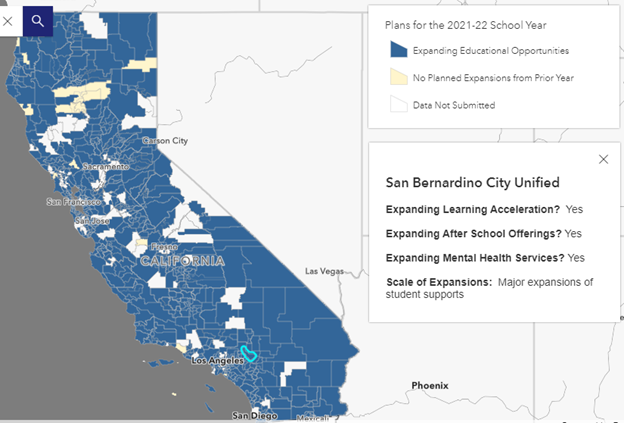Vast majority of school districts have used state investments to expand mental health services, after-school programs and tutoring for the new school year
New student supports for academic and mental well-being set the foundation for the transformation of public schools using California’s historic $123.9 billion TK-12 budget
SACRAMENTO – California has released new data reflecting early results of historic investments Governor Gavin Newsom has made in education. As schools fully open for the new school year, school districts across the state have expanded services to meet the needs of returning students: 98 percent of school districts report expanding educational opportunities, including mental health, after-school and academic supports. Specifically:
- 95 percent of school districts report expanding mental health and wellness services
- 73 percent of school districts report expanding after-school programs
- 83 percent of school districts report expanding learning acceleration programs (e.g., high-dose tutoring)
The state’s new Statewide Expanded Educational Opportunities Dashboard provides the latest statewide snapshot:

Additionally, the new School Districts Expanded Opportunities Map provides region-specific data for parents, families and others in the community to find out whether their schools are offering additional mental health and academic services:

Through the winter, the Governor championed urgent action to provide school funding to both accelerate school reopenings in the 2020-21 school year and expand student supports for the summer and 2021-22 school year. AB 86 was enacted on March 5, 2021, with $4.6 billion (of $6.6 billion in total funding) dedicated to expanding student supports. Schools used those early funds to expand educational opportunities for the summer and the upcoming school year. According to the summer data, 89 percent of school districts reporting offered new learning opportunities over the summer, including learning acceleration (e.g., high-dose tutoring), enrichment and mental health services.
Building on this funding, the Governor championed a historic $123.9 billion K-12 education package that represents a transformation of our public schools over the next several years. Here are some of the highlights of how investments in AB 86 meet the immediate needs of students, as well as set the foundation for the Governor’s historic education budget package:
|
Priority |
2021-22 School Year |
Longer-Term Transformation |
|
Supporting the Whole Child |
AB 86 funds for the “provision of health, counseling, or mental health services, access to school meal programs, . . . , or programs to address pupil trauma and social-emotional learning, or referrals for support for family or pupil needs.”
Approx. 95 percent of responding school districts report “expanding mental health and wellness services” this school year. |
$4.3 billion to transform the youth behavioral health system, focusing on early identification of trauma, depression, anxiety, substance abuse, etc.
$3 billion to create thousands of full-service community schools.
$650 million in ongoing funds for universal free school nutrition. |
|
Increasing Learning Time |
AB 86 funds to “extend instructional learning time,” “provid[e] summer school or intersessional instructional programs, and provide access to before and after school programs.”
Approx. 88 percent of responding school districts reported offering summer school, enrichment programs, etc.
Approx. 83 percent of responding school districts report “expanding after-school programs” this school year. |
$1.8 billion, growing to $5 billion ongoing by 2025, to achieve universal access to summer and after-school programs.
Universal TK for all four-year-olds by 2025, adding an extra year of public education. -$300 million for the pre-K teacher pipeline. -$490 million to build and renovate state preschool, transitional kindergarten and kindergarten facilities. |
|
Improving Quality of Learning Time |
AB 86 funds for “[t]utoring or other one-on-one or small group learning supports,” “[l]earning recovery programs and materials designed to accelerate pupil academic proficiency,” “[s]upports for credit deficient pupils to complete graduation or grade promotion,” etc.
Approx. 74 percent of responding school districts report “expanding learning acceleration” programs, including “high-dose tutoring.” |
$1.1 billion in ongoing funds for high-poverty schools to hire up to five additional teachers, paraeducators, counselors, etc.
$2.9 billion to expand the teacher pipeline and match well-prepared teachers to vulnerable students, such as $250 million to attract board-certified expert teachers to high-need schools.
$1.5 billion to improve special education. |
###
